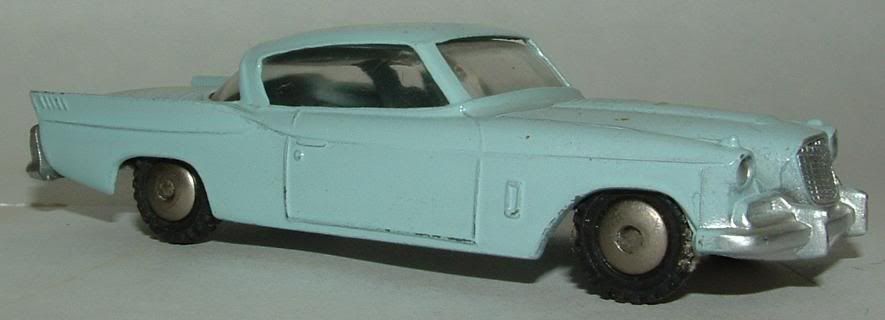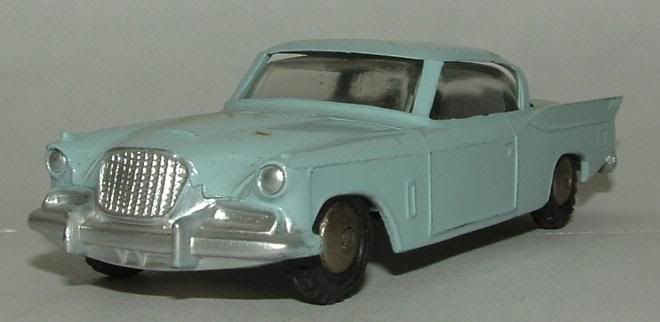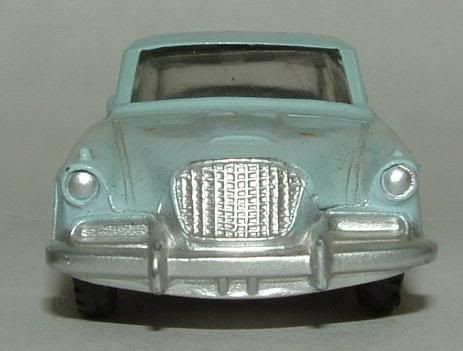
A blog focusing on 1/64 diecast from such popular brands as Hot Wheels, Matchbox, Johnny Lightning, M2 Machines, GreenLight, Tomica, Yat Ming, Majorette, MotorMax, Siku, Corgi, Guisval, Playart, Ertl, Zylmex, Racing Champions, & many more. Swifty's Garage features a daily Car Of The Day and news updates from your favorite brands!
Friday, February 18, 2011
Car Of The Day: February 18, 2011
Today's car of the day comes from Bruce Slifer's collection and is Hubley's 1958 Studebaker Silver Hawk.
The Studebaker Silver Hawk was an automobile produced between 1957 and 1959 by the Studebaker Corporation of South Bend, Indiana. The Hawk was also produced in 1956. There were four versions, pillared Flight Hawk and Power Hawk, and hardtop Sky Hawk and Golden Hawk. The Silver Hawk model was not produced in 1956, the first year of the Hawks. The same basic car was produced for two more years (1960 and 1961) as simply the Studebaker Hawk, since from 1959 onward no other Hawk models were being sold.
For more information and pictures of the real car please visit: Studebaker Silver Hawk
Just when it was beginning to look like Studebaker week had turned into Shrock Brothers Studebaker week, here's a nice offering from Hubley. It's unique among the cars featured this week in that it was actually offered when the real car was in showrooms!
The Silver Hawk was the replacement for the two lower models in the four-model Hawk range in 1956, the Flight Hawk which carried the Champion 185 cu. in., six-cylinder 101 hp (75 kW) powerplant and the Power Hawk with the Commander's 259 in³ (4.2L) V8. Both of these models were two-door pillared coupes in the US market (based on the 1953 "Starlight" coupe body), and therefore, so was the Silver Hawk, which came in two differently-engined models with either the aforementioned Champion six or the 289 cu. in. (4.7L) President V8 engine (delivering 210 HP from the two-barrel, 225 HP from the four-barrel with dual exhaust). The Commander V8 was not offered in U.S. models; it was, however, the largest engine available in most overseas markets.
In appearance, the Silver Hawk was somewhat plainer in appearance than the Golden Hawk, the senior of the two Hawk models in 1957-58. There was a little bit less chrome, no supercharger or bulge in the hood, and a simpler two-tone paint scheme was adopted - simply one color below the chrome belt line and another above, but unlike the Golden Hawk, the lower color included the fin. Some dealers painted the fin only, and sometimes the deck lid recess and or the left and right "side grills" were painted in a contrasting Studebaker color. These usually matched the interior, some were Blue, Gold, Red or Black and were actually better looking according to many owners than the factory two-tone paint scheme.
In the midst of a financial crisis at Studebaker after a disastrous recession-year performance in 1958, the Golden Hawk was dropped; the Silver Hawk, which had sold somewhat better, was retained in the lineup.
For 1959, the Silver Hawk became the only Hawk model in production, largely because Studebaker dealers wanted a glamorous flagship model as a dealership draw. Those customers would more than likely walk out with Studebaker's last-ditch hope, the new Lark compact. In fact, the Silver Hawk was the only non-Lark model kept.
Changes for 1959 included new tailfins, with the "Silver Hawk" script moved to the fins instead of on the trunk lid (where new individual block letters spelling out STUDEBAKER were placed), with a new Hawk badge in between the two words. The parking lights moved to the side grilles from the front fenders, chrome moldings around the windows (from the '53-'54 models) similar to the Golden Hawk were added, and the interior was somewhere in between the two former models' levels of luxury. Two-tone paint was discontinued for all US orders, though it was still available for export.
Under the hood (at least for U.S. models), buyers could choose the newly-shrunken (to pre-'55 size) 90 HP 169.6 cu. in. (2.8L) six or the 259 cu. in. (4.2L) V8 of 180 or 195 HP (depending on the choice of carburetor). The 289 was no longer available.
The 1959 model year was Studebaker's first profitable year in six years, thanks mostly to the Lark, and the rising tide of sales lifted the Silver Hawk, which sold 7,788 examples.
For 1960, Studebaker dropped the Silver part of the name, leaving "just plain" Hawk. Largely unchanged externally from the '59, internally, the major change was the return of the 289 cubic inch (4.7 L) V8 last used in 1958. This was the only engine available for U.S. orders in both 1960 and 1961, the last year of the finned Hawk. Some 6-cylinder and 259 in³ (4.2 L) V8 models were built for export markets.
The 1961 models saw the limited return of a second paint color, beige, in a stripe along the base of the fin between the two lower moldings. Interiors gained the option of wide, comfortable bucket seats; customers could opt to team their 289 V8 with a new four-speed Borg-Warner manual transmission, the same model used in the Chevrolet Corvette.
The Hawk was replaced for 1962 by the stunningly-restyled (by Brooks Stevens) Studebaker Gran Turismo Hawk.
As can be seen in some of these pictures, this car suffers from something current Hot Wheels and Matchbox cars will not have to worry about- and that is a few spots of rust affecting what is otherwise a very mint survivor from the 1950s. Back then toys were built from metal, and intended to last. Too bad the same can not be said of the company itself (in this case, both Hubley and Studebaker).
Subscribe to:
Post Comments (Atom)







No comments:
Post a Comment